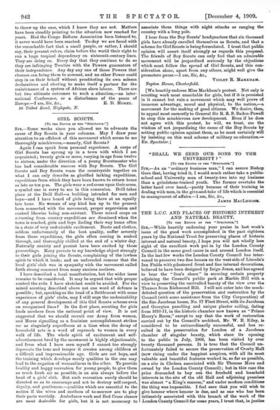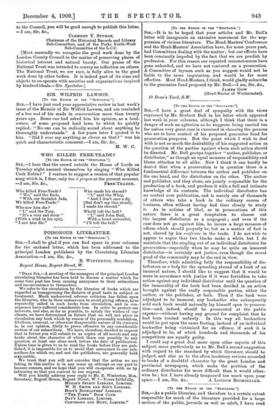THE L.C.C. AND PLACES OF HISTORIC INTEREST AND NATURAL BEAUTY.
[To THE ED/TOR OP THE 46 SPBCTATOB."1 SIR,—While heartily endorsing your praise in last week's issue of the good work accomplished in the past eighteen years by the National Trust for preserving places of historic interest and natural beauty, I hope you will not wholly lose sight of the excellent work put in by the London County Council in the same good cause in and around London itself. In the last few weeks the London County Council has inter- vened to preserve two fine houses on the west side of Lincoln's Inn Fields with pilastered front and fine internal decorations, believed to have been designed by 'nig° Jones, and has agreed to bear the "lion's share" in securing certain property adjoining the Council's public park at Marble 11111 with a view to preserving the unrivalled beauty of the view over the Thames from Richmond Hill. I will not enter into the much- debated question of the preservation and restoration by the Council (with some assistance from the City Corporation) of the fine Jacobean house, No. 17 Fleet Street, with its Jacobean and Georgian panelling and unique plaster ceiling, dating from 1610-11, in the historic chamber now known as " Prince Henry's Room," except to say that the work of restoration carried out by the Council's architect, Mr. W. E. Riley, is considered to be extraordinarily successful, and has re- sulted in the preservation for London of a Jacobean chamber of singular beauty, which since its opening to the public in July, 1906, has been visited by over twenty thousand persons. It is true that the Council un- fortunately failed to secure the preservation of Crosby Hall (now rising under the happiest auspices, with all its most valuable and beautiful features worked in, so far as possible, on a site in Chelsea associated with Sir Thomas More and owned by the London County Council) ; but in this case the price demanded to buy out the freehold and leasehold interests in the site of the old Hall and adjoining premises was almost " a King's ransom," and under modern conditions the thing was impossible. I feel sure that you will wish to give honour where honour is due, and as one who has been intimately associated with this branch of the work of the London.County Council for some years, I trust that, in justice
to the Council, you will be good enough to publish this letter.
am, Sir, &c.,
CLEMENT Y. STITRGE, Chairman of the Historical Records and Library Sub-Committee, and of the Parks No.rth-West Sub-Committee of the L.C.C.
[Most assuredly we recognise the good work done by the London County Council in the matter of preserving places of historical interest and natural beauty. Our praise of the National Trust was intended to convey no reflection on others. The National Trust, we are sure, is fully alive to the good work done by other bodies. It is indeed part of its aims and
objects to co-operate with societies and organisations inspired by kindred ideals.—ED. Spectator.]







































































 Previous page
Previous page